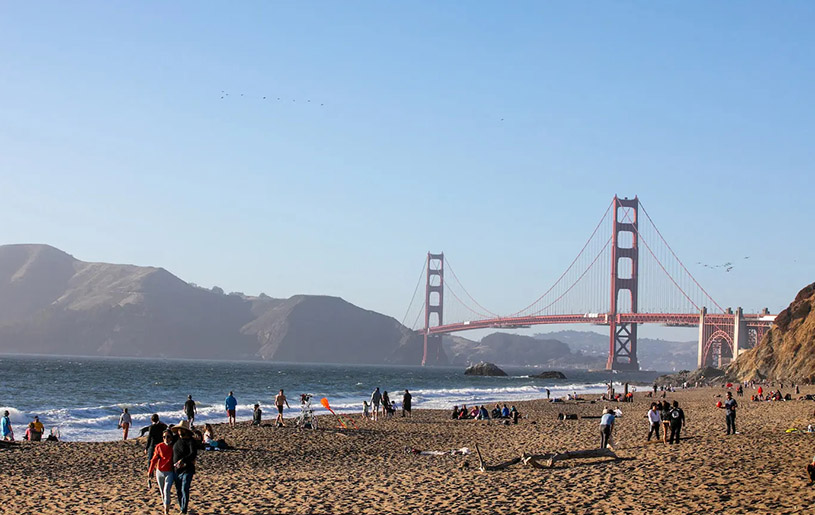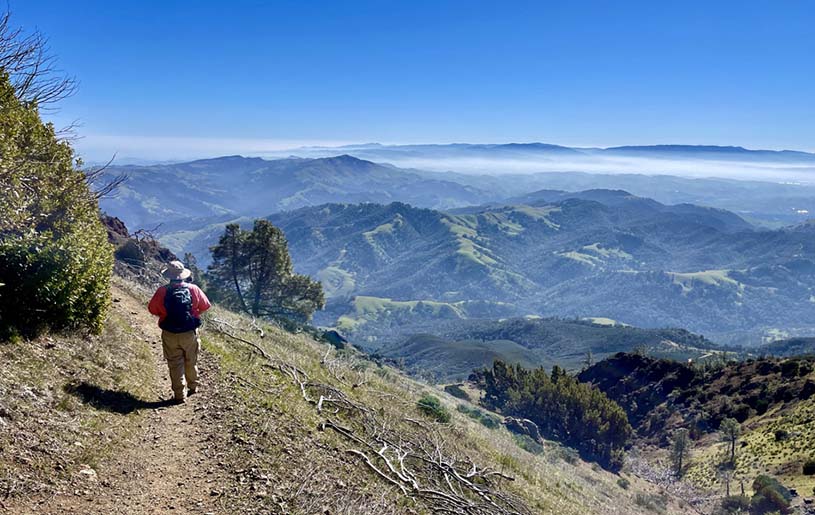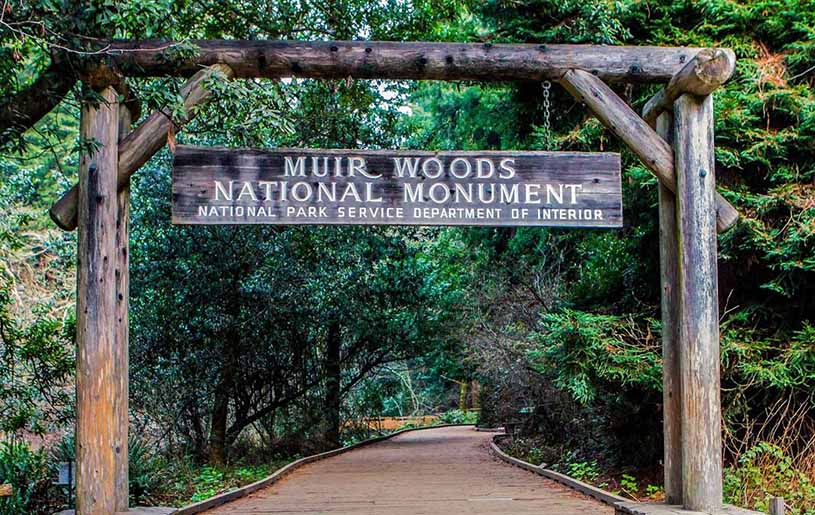
San Francisco is not only known for its bustling urban landscape and cultural heritage, but also for its rich natural landscapes and unique geographical location, making the city a paradise for hikers. From the majestic Golden Gate Bridge to the winding coastline to the rolling mountains, San Francisco’s hiking routes provide perfect options for hikers of all levels. Whether you are a novice or an experienced hiker, you will find a route suitable for you around the city.
1. Overview of San Francisco’s Natural Landscape
1.1 Geography and Climate of San Francisco
San Francisco is geographically unique. It is located on the Pacific coast and has rich mountains, oceans, forests and grasslands. In addition, the city has a mild climate, which is suitable for outdoor activities all year round. San Francisco’s climate is characterized by a typical Mediterranean climate, with cool summers and mild and humid winters. Therefore, hiking and hiking are possible activities between the four seasons. The natural landscape here is not only a paradise for hikers, but also a paradise for photography enthusiasts.
1.2 Popularity of Hiking and Hiking Activities
Due to the attractive natural landscapes near San Francisco, hiking has become an important part of the daily life of many tourists and local residents. Whether you want to feel the sea breeze and the sea up close or want to swim among the mountains, San Francisco’s diverse hiking routes can meet the needs of hikers with different needs.
2. Must-go coastal hiking routes
2.1 Golden Gate Park & Coastal Trail
Golden Gate Park is one of the largest urban parks in San Francisco. The park has abundant green space and trails, which are perfect for walking and easy hiking. The coastal trail in Golden Gate Park follows the Pacific coastline, presenting a series of beautiful beaches, cliffs and the Golden Gate Bridge in the distance. Visitors can feel the strong ocean atmosphere here and enjoy the excellent sea view on the trail.
Route highlights:
Starting point: Entrance of Golden Gate Park
Passage: Golden Gate Bridge, Crissy Field, Baker Beach
Distance: About 8 kilometers
Difficulty: Moderate, suitable for most hikers
Time: About 2-3 hours
Best season:
Summer and autumn are the best time. The mild climate and fresh sea breeze will make you feel the fun of coastal hiking.
2.2 Ocean Beach Trail
The Ocean Beach Trail connects to Ocean Beach in San Francisco and is a great route for hiking and walking. You can enjoy the beauty of the sea and the beach here. The sound of waves hitting the shore and the sea breeze make this route very popular.
Route highlights:
Starting point: Ocean Beach
Visit: Sutro Baths, Lands End Lookout
Distance: about 3-4 kilometers
Difficulty: easy, suitable for families and casual hikers
Time: about 1-2 hours
Best season:
The Ocean Beach Trail is suitable for hiking all year round, especially in the warm spring and autumn seasons, when the weather is pleasant and suitable for taking family or friends for a walk.
3. Classic mountain hiking route
3.1 Mount Diablo Hiking
Mount Diablo is a famous peak in the Bay Area, located east of San Francisco, providing a breathtaking panoramic view. Standing on the top of the mountain, you can see the beautiful scenery as far as Silicon Valley, the Sierra Nevada Mountains, and even Sacramento. Dante Mountain is not only a great place for hiking, but also an ideal place for rock climbing enthusiasts.
Route highlights:
Starting point: Danville entrance
Route: Danville Trail, Summit Trail
Distance: about 10-12 kilometers
Difficulty: high, suitable for experienced hikers
Time: about 4-5 hours
Best season:
Spring and autumn are the best, with suitable climate, blooming mountain flowers, and the most charming scenery.
3.2 Mount Tamalpais Hiking
Mount Tamalpais is one of the iconic mountains in the North Bay area and a paradise for hikers. There are many hiking routes on the mountain, which allow you to gain an in-depth understanding of the rich vegetation and animal communities. Standing on the top of the mountain, you can see San Francisco, the Golden Gate Bridge, and even the ocean in the distance, which is picturesque.

Route highlights:
Starting point: Pantoll Campground
Via: Matt Davis Trail, Steep Ravine Trail
Distance: about 8-14 kilometers
Difficulty: moderate to high
Time: about 3-6 hours
Best season:
Summer and autumn are the best time to hike Kubi Mountain. The warm weather and dry air make hiking more enjoyable.
4. Other hiking and trekking recommendations
4.1 Crossing the Redwood National Monument
Redwood National Monument is one of the most famous nature reserves in the United States and has the tallest trees in the world. The hiking trails here go deep into the dense forest, where visitors can walk under the shadows of the trees and feel the mysterious forest atmosphere. The giant redwood trees and rich vegetation make this hiking route a must-see for many hikers.
Route highlights:
Starting point: Muir Woods entrance
Visit: Main Trail, Bootjack Trail
Distance: about 6 kilometers
Difficulty: moderate, suitable for all ages
Time: about 2-3 hours
Best season:
Spring and autumn are the best time for hiking, when the weather is mild and the redwoods are the most green.
4.2 Golden Gate National Recreation Area
Located next to the Golden Gate Bridge, the Golf Bay Nature Reserve is a great area for family hiking and wildlife observation. There are many trails of different difficulties here, allowing you to relax in nature and enjoy the beautiful scenery.
Route highlights:
Starting point: Fort Point
Visit: Battery Spencer, Rodeo Beach
Distance: about 5-10 kilometers
Difficulty: moderate, suitable for family outings
Time: about 2-4 hours

Best season:
It is suitable for hiking all year round, especially in spring and autumn when the weather is pleasant.
5. Essential Equipment and Some Hiking Tips
5.1 Essential Equipment
Proper equipment can ensure your safety and comfort during hiking and walking tours in San Francisco. Here are some essential equipment:
Proper hiking shoes: Hiking routes often have difficult terrain, so make sure you wear comfortable and supportive hiking shoes, especially when hiking in the mountains, where slip resistance and stability are crucial.
Backpack and water bottle: Bring a backpack suitable for hiking to store your water, food, and spare clothes. Make sure to replenish water at all times, especially in the summer when the weather is hot.
Sunscreen and hat: Even on cloudy days, ultraviolet rays are still strong. Applying sunscreen and wearing a wide-brimmed hat can effectively prevent sun damage.
First aid kit: A lightweight first aid kit can help you deal with emergencies such as minor scratches and insect bites.
Maps and navigation tools: Even though most trails are well marked, bring a paper map or use a mobile navigation tool (such as AllTrails) to prevent getting lost.
5.2 Hiking Tips
Plan ahead: Make sure you understand the route you choose, especially the length, difficulty, and estimated time of the route.
Take breaks: Don’t forget to take regular breaks during your hike, especially on steep sections, to avoid excessive fatigue.
Adapt to climate change: San Francisco’s weather is unpredictable, so be prepared for sudden fog or cold weather. Bring a windproof jacket for emergencies.
Travel with others: Try to avoid hiking alone, especially in more remote areas. Hiking with friends can increase safety and share beautiful scenery.
5.3 Hiking Tips
Although San Francisco’s hiking and hiking routes are beautiful, visitors need to pay attention to the following points to ensure safety and complete hiking activities successfully:
Know the weather forecast: San Francisco’s weather is unpredictable, especially in the mountains and coastal areas. Before hiking, be sure to check the weather forecast, especially wind speed, rainfall, and temperature. Avoid hiking during storms or extreme weather.
Wear layers: San Francisco’s temperature varies greatly, especially in coastal areas. Dress in layers so you can add or remove clothing as the temperature changes. For example, when hiking on the beach, the daytime temperature is high, but when you reach the top of the mountain, the temperature may drop sharply, requiring extra layers of warmth.
Water and supplies: Many hiking routes do not have direct access to water sources, so be sure to carry plenty of water and high-energy foods (such as nuts and energy bars). Staying hydrated is especially important during the hot summer months.
Watch for wildlife: The mountains and nature reserves around San Francisco are home to many wild animals. Although most animals will not attack, you should still be alert and avoid getting too close to animals, especially wild deer, mountain lions, and other large animals. Keep a certain distance and follow local safety guidelines.
Respect the natural environment: Keep the environment clean during hiking. Do not leave trash or damage plant and animal habitats. Follow the principle of “leave footprints, leave no trash” and respect the rules of the nature reserve.
Plan your time appropriately: Hiking activities should be arranged according to your own physical strength and ability, especially long routes. Calculate the estimated time in advance to ensure that you complete the return journey before dark. If you choose a longer route, you can prepare first aid equipment and navigation tools in advance.
The hiking and walking routes in and around San Francisco provide visitors with unparalleled natural beauty and outdoor activities. From coastline to mountains, from gentle walks to more challenging routes, the city has something for almost every hiking enthusiast. To ensure your hiking trip is smooth and enjoyable, remember to plan your trip in advance, especially during peak tourist season.


